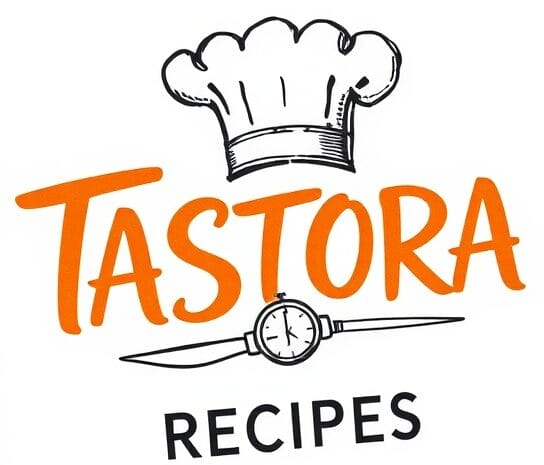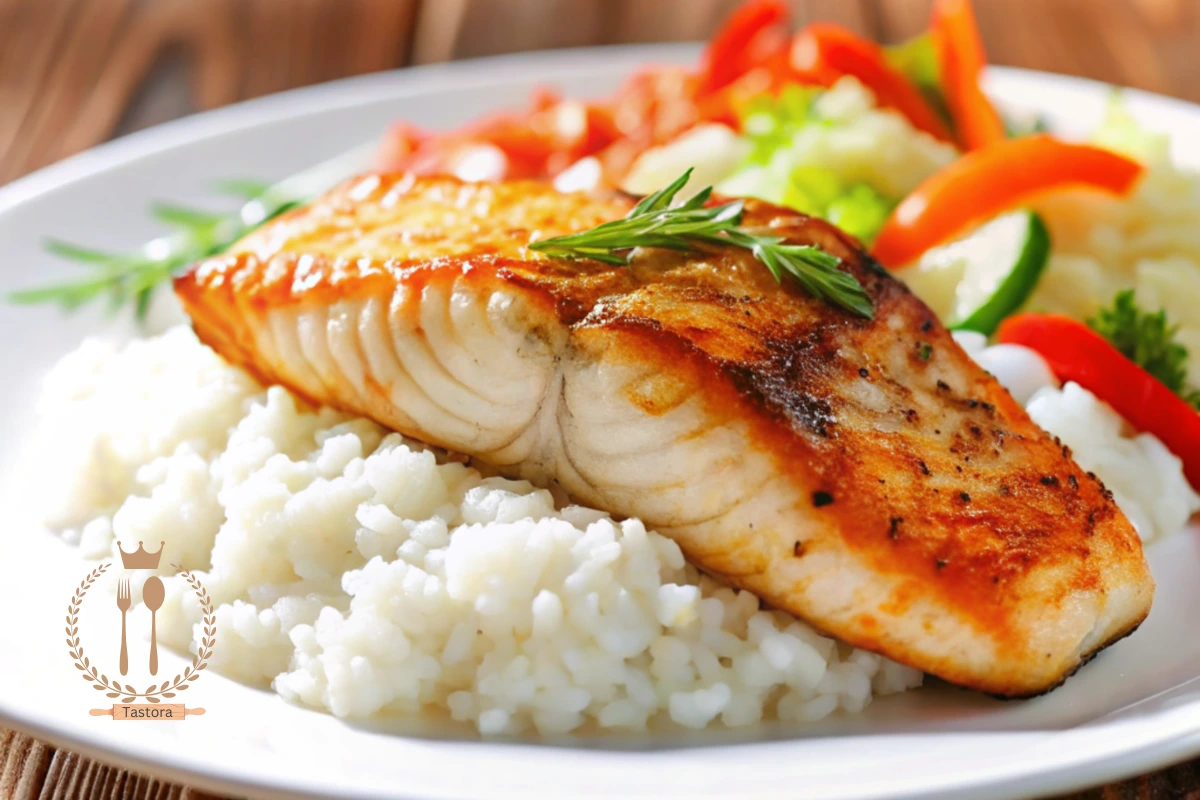Old Fashioned Salmon and Rice: A Timeless Family Favorite
In a world of flashy food trends and exotic ingredients, there’s something profoundly comforting about returning to the classics. Old fashioned salmon and rice isn’t just a recipe—it’s a piece of American culinary heritage that has stood the test of time for good reason. This humble yet satisfying dish combines the rich omega-3 goodness of salmon with fluffy, absorbent rice to create a meal that feels like a warm hug from Grandma. Whether you grew up with this dish gracing your family table or you’re discovering it for the first time, there’s something magical about the way these simple ingredients come together to create something greater than the sum of their parts. Join us as we explore this budget-friendly, protein-packed classic that continues to win hearts and fill bellies across America’s dinner tables.
Why Old Fashioned Salmon and Rice Is Still a Family Favorite
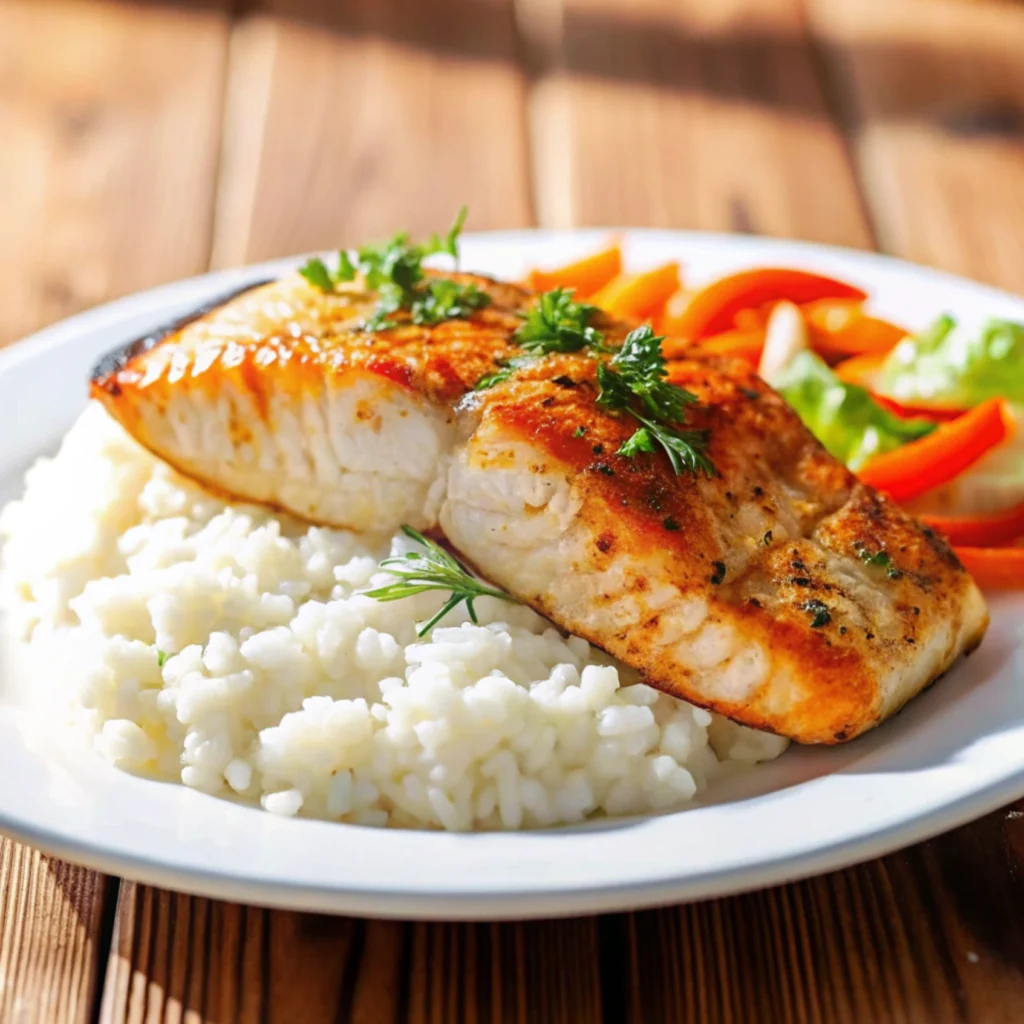
The Roots of Classic Salmon and Rice in American Home Cooking
The marriage of salmon and rice in American kitchens dates back generations, finding particular popularity during the Great Depression and World War II when canned salmon offered an affordable protein source. This ingenious combination emerged from necessity but endured because of its delicious practicality. Coastal communities had long incorporated fresh salmon into their diets, but the innovation of canning brought this nutritious fish inland, where it became a staple in heartland cooking. The recipe’s origins reflect American resourcefulness—transforming simple ingredients into a meal that satisfied both nutritional needs and taste buds during challenging times.
Why This Dish Remains Popular Across Generations
Few dishes can claim the cross-generational appeal of salmon and rice. Parents appreciate its nutritional profile and ease of preparation, while children enjoy its mild, approachable flavor. The recipe has been passed down through family cookbooks, each generation adding their own subtle tweaks while maintaining the core elements that make it special. Its adaptability means it can be dressed up for Sunday dinner or simplified for a quick weeknight meal, making it versatile enough to stay relevant through changing lifestyles and dietary preferences. The dish’s staying power also comes from its ability to scale—feeding a large family gathering or providing perfect portions for empty nesters.
Comfort Food Appeal and Nostalgic Flavors
There’s science behind why salmon and rice feels so satisfying—the combination of protein, healthy fats, and complex carbohydrates creates a perfect comfort food trifecta. The dish hits those nostalgic notes with its savory aroma filling the kitchen, reminiscent of simpler times when families gathered around the table each evening. The gentle flavors of flaked salmon, enhanced by aromatic vegetables and subtle seasonings, create a dish that soothes the soul while nourishing the body. It’s the kind of meal that evokes memories—perhaps of Grandma’s kitchen or Mom’s weeknight rotation—making it as emotionally satisfying as it is physically filling.
The Budget-Friendly Nature of Canned Salmon and Pantry Staples
In today’s world of fluctuating food prices, salmon and rice remains remarkably economical. Canned salmon delivers impressive nutrition at a fraction of the cost of fresh fillets, while rice stretches the protein to feed more mouths. The recipe primarily relies on pantry staples and long-lasting ingredients, reducing waste and allowing for spontaneous meal preparation without special shopping trips. This financial efficiency doesn’t compromise quality—canned salmon often contains all the nutritional benefits of fresh, including those precious omega-3 fatty acids. For families on a budget or anyone looking to maximize their grocery dollars, this dish demonstrates that economical eating doesn’t have to sacrifice flavor or nutrition.
Ingredients You’ll Need for Traditional Salmon and Rice
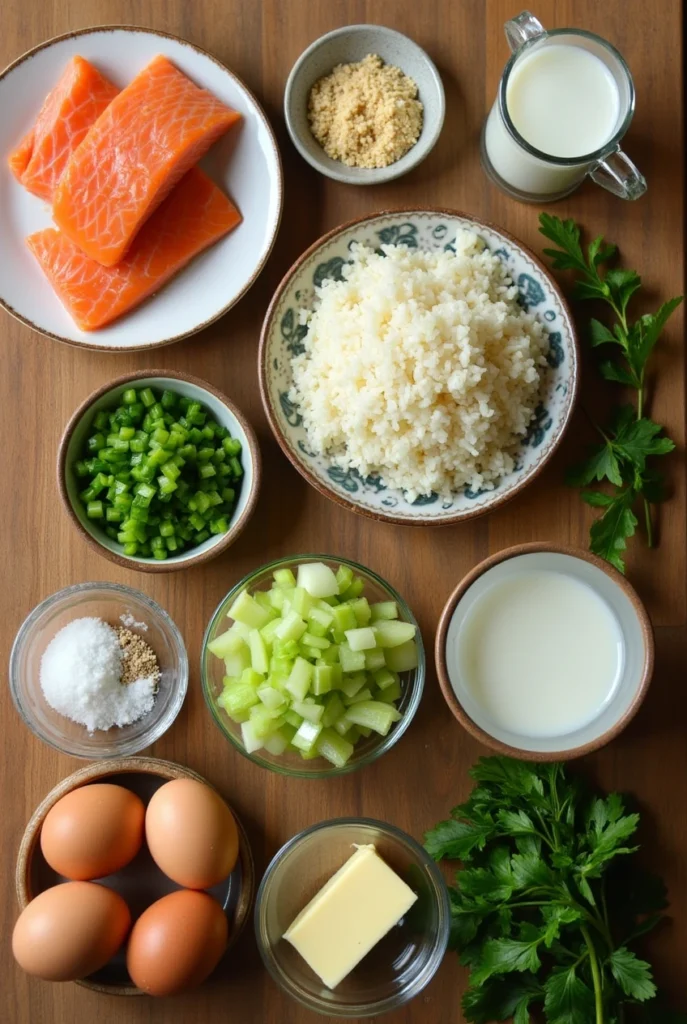
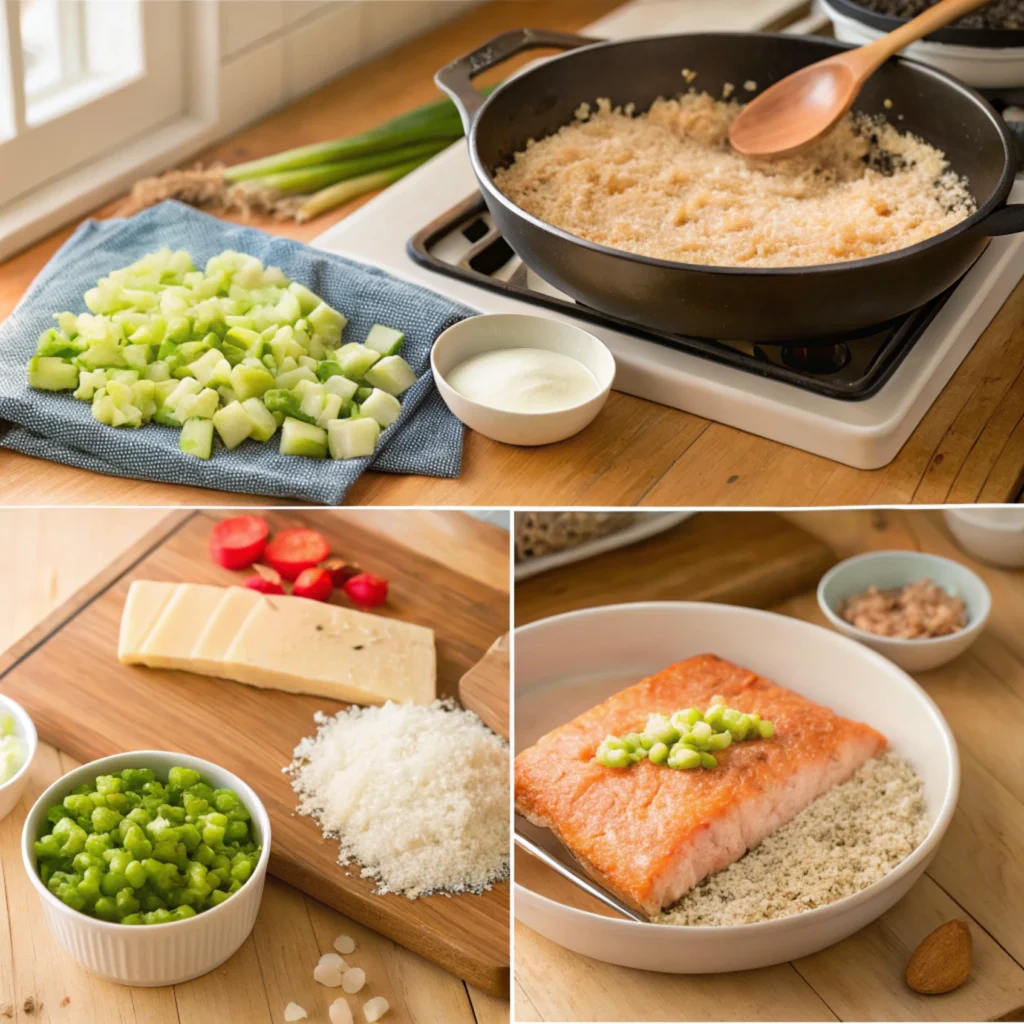
Ingredients
- 1 can (14-15 oz) pink salmon, drained and flaked (remove skin and bones if desired)
- 2 cups cooked white rice (long grain or leftover rice works best)
- 1/2 cup finely chopped onion
- 1/2 cup finely chopped celery
- 1/2 cup chopped green bell pepper
- 2 large eggs, lightly beaten
- 1/2 cup milk
- 1/2 cup breadcrumbs (plain or seasoned)
- 2 tablespoons butter (plus extra for greasing)
- 1/4 teaspoon garlic powder
- Salt and black pepper to taste
- Fresh parsley for garnish (optional)
Preparation Steps
1. Preheat and Prepare
- Preheat your oven to 350°F (175°C).
- Lightly butter a medium baking dish or casserole dish and set aside.
2. Sauté Vegetables
- In a skillet over medium heat, melt the butter.
- Add chopped onions, celery, and green bell pepper.
- Cook until softened, about 5–7 minutes. Remove from heat and let cool slightly.
3. Mix Ingredients
- In a large bowl, combine the cooked rice, flaked salmon, sautéed vegetables, eggs, milk, and breadcrumbs.
- Season with garlic powder, salt, and pepper.
- Mix gently until all ingredients are evenly combined.
4. Bake the Dish
- Spoon the mixture into the prepared baking dish and smooth the top.
- Bake uncovered for 30–35 minutes, or until golden on top and firm in the center.
5. Serve and Enjoy
- Let rest for 5 minutes before serving.
- Garnish with fresh parsley if desired.
- Serve hot with your favorite sides like green beans or cornbread.
Canned Salmon or Fresh Cooked Salmon
The cornerstone of this classic dish is, of course, the salmon itself. Traditional recipes typically call for canned salmon, which offers remarkable convenience and value. Look for wild-caught Alaskan varieties for the best flavor and nutritional profile. One of the hidden advantages of canned salmon is that it often includes the soft, calcium-rich bones, which become completely unnoticeable when mixed into the dish while adding significant nutritional benefits. The oil and juices from the can also contribute flavor, so don’t drain completely unless the recipe specifically calls for it.
For those who prefer fresh salmon, approximately one pound of cooked and flaked fish makes an excellent substitute. Poaching or gentle baking works best to maintain moisture without adding competing flavors. Leftover salmon from a previous meal works wonderfully too, giving new life to remains that might otherwise go to waste. Whether canned or fresh, the salmon provides protein, omega-3 fatty acids, and that distinctive flavor that carries the entire dish.
Long Grain White Rice or Cooked Leftover Rice
Rice serves as both foundation and extender in this dish, absorbing flavors while adding satisfying texture and volume. Long grain white rice is traditional, offering fluffy grains that maintain their structure when mixed with other ingredients. For best results, cook the rice slightly al dente before combining it with salmon, as it will continue absorbing moisture during the final preparation.
Day-old rice works exceptionally well in this recipe—in fact, many home cooks purposely make extra rice for dinner specifically to use in salmon and rice the next day. The slightly dried texture of refrigerated rice helps prevent mushiness in the final dish. If using leftover rice, you’ll need approximately 3-4 cups for a family-sized portion. Brown rice can substitute for added fiber and nutrition, though cooking time and liquid ratios should be adjusted accordingly. The rice component provides the comforting carbohydrate base that makes this dish so satisfying and helps stretch the salmon to feed more people economically.
Aromatics: Onions, Celery, and Bell Peppers
The fragrant foundation of salmon and rice comes from its aromatic vegetables, which perfume the dish while adding texture, color, and nutrition. Finely diced onions contribute sweetness when sautéed until translucent, while celery adds a subtle crunch and earthiness. Bell peppers—traditionally green, though red or yellow add cheerful color—bring a mild sweetness and vitamin boost.
These aromatics should be diced to a similar size for even cooking and distribution throughout the dish. Sautéing them in butter or oil before combining with other ingredients helps release their flavors and soften their texture. The classic ratio calls for about half a cup each of diced onion and celery, with a quarter cup of bell pepper, though many family recipes adjust these proportions based on preference. Together, these vegetables create the flavor base known in culinary traditions as “mirepoix” or “holy trinity,” depending on the region—proof that this humble dish shares techniques with more sophisticated cuisine.
Pantry Staples: Eggs, Milk, Breadcrumbs, Seasonings
The binding agents and flavor enhancers in traditional salmon and rice come from common pantry items, making this truly a “whip it up anytime” meal. Eggs serve as the primary binder, creating a cohesive texture while adding protein. One or two eggs beaten with a splash of milk (about ¼ cup) provides just enough moisture to bring the dish together without making it soggy.
Breadcrumbs—either store-bought or homemade from stale bread—add texture and help absorb excess moisture. For seasoning, simplicity reigns: salt and pepper form the base, while lemon pepper, dried dill, or Old Bay seasoning are common enhancements that complement the salmon without overwhelming it. A touch of Dijon mustard or Worcestershire sauce can add depth, while a sprinkle of paprika on top provides both color and a mild smoky note. These pantry ingredients transform simple components into a cohesive, flavorful dish, proving that exceptional cooking often requires nothing more than what’s already in your kitchen.
How to Make Old Fashioned Salmon and Rice at Home
Preparing the Rice for the Best Texture
The foundation of exceptional salmon and rice begins with properly cooked grains. For ideal texture, rinse your rice under cold water until the water runs clear, removing excess starch that can cause gumminess. Use a 1:2 ratio of rice to water for long grain varieties, bringing the water to a boil before reducing to a gentle simmer and covering. Resist the urge to peek or stir—undisturbed cooking allows the rice to steam properly. For this dish, cook the rice until it’s just tender but still has a slight bite, as it will absorb additional moisture from other ingredients later.
Timing matters significantly: rice made specifically for this dish should cool for at least 15 minutes before incorporating other ingredients, allowing excess moisture to evaporate. Even better is day-old refrigerated rice, which develops a slightly drier texture perfect for absorbing the salmon’s flavors without becoming mushy. If you’re short on time, spread freshly cooked rice on a baking sheet and place in the refrigerator for 15-20 minutes to accelerate cooling. This attention to the rice’s preparation pays dividends in the final texture of your dish.
How to Mix Salmon with Aromatics and Binders
The key to harmonious salmon and rice lies in how you combine the components. Begin by sautéing your aromatics in butter or oil until fragrant and slightly softened—about 3-5 minutes over medium heat. While those cool slightly, drain your canned salmon, reserving a tablespoon of the liquid for flavor. Gently flake the salmon with a fork, removing larger bones if desired (though the smaller ones are soft, nutritious, and virtually undetectable in the finished dish).
In a large mixing bowl, combine the cooled rice and flaked salmon first, using a gentle folding motion to maintain texture. Add the sautéed aromatics next, continuing to fold rather than stir vigorously. In a separate small bowl, whisk together your binders—typically eggs, a splash of milk, and seasonings—until smooth. Pour this mixture over the salmon and rice, then fold everything together until just combined. Overmixing compacts the dish and makes it dense, so use a light hand. The mixture should be moist enough to hold together when pressed but not soggy. If needed, add breadcrumbs a tablespoon at a time to achieve the right consistency.
Cooking Options: Stovetop Skillet, Oven-Baked, or Casserole Style
One of this dish’s greatest virtues is its versatility in preparation methods. For the stovetop skillet version, heat 2-3 tablespoons of butter or oil in a large skillet over medium heat. Add the mixture, pressing it into an even layer, and cook undisturbed for 5-7 minutes until golden brown on the bottom. Either flip the entire cake or break it into portions to turn and brown the other side for another 5 minutes.
For oven-baked preparation, preheat your oven to 350°F. Transfer the mixture to a greased 9×13 baking dish, pressing into an even layer. Bake uncovered for 25-30 minutes until the top develops a light golden crust. This method yields a more cohesive, casserole-style result.
The traditional casserole approach adds a creamy element: mix a simple white sauce (2 tablespoons butter, 2 tablespoons flour, 1 cup milk) and fold into the salmon mixture before transferring to a baking dish. Top with additional breadcrumbs mixed with a bit of melted butter, then bake at 350°F for 35-40 minutes until bubbling around the edges and golden on top. Each cooking method produces a slightly different texture and presentation while maintaining the dish’s essential character.
Tips for Achieving a Flavorful, Moist Dish Without It Being Too Heavy
The perfect salmon and rice walks the line between moist and heavy, flavorful and overwhelming. To maintain this balance, use these time-tested techniques: First, don’t completely drain the canned salmon—a tablespoon of its liquid adds flavor and moisture. Second, sauté your aromatics thoroughly before adding them to the mixture; raw vegetables release water during cooking that can make the dish soggy.
Herbs and acid brighten the dish considerably—fresh dill, parsley, or chives added at the end provide freshness, while a squeeze of lemon juice just before serving cuts through richness. For moisture without heaviness, consider using Greek yogurt instead of all the milk in your binder mixture, providing creaminess with a tangy counterpoint.
Watch your heat carefully during cooking—too high, and the outside will burn while the inside remains underdone; too low, and the dish becomes soggy as moisture can’t escape. If the mixture seems too wet before cooking, add breadcrumbs incrementally rather than all at once. Conversely, if it’s too dry, a tablespoon of mayonnaise can add moisture and richness without making the dish watery. Remember that the dish will continue to set as it rests, so allow 5-10 minutes standing time before serving for optimal texture.
Serving Suggestions for a Classic Salmon and Rice Dinner
Best Side Dishes: Collard Greens, Green Beans, or Roasted Vegetables
The ideal accompaniments to salmon and rice provide contrasting flavors and textures while complementing its mild savoriness. Traditional Southern-influenced pairings feature collard greens simmered with a touch of vinegar and red pepper flakes, offering tangy brightness that cuts through the dish’s richness. The slight bitterness of collards also provides excellent balance to the salmon’s flavor profile. Fresh green beans steamed until just tender-crisp and finished with a squeeze of lemon and sprinkle of almonds offer a lighter alternative with similar complementary properties.
For a more contemporary approach, roasted vegetables provide caramelized sweetness and textural contrast. Brussels sprouts, butternut squash, or a medley of root vegetables roasted at high heat until their edges crisp work particularly well. Season these simply with olive oil, salt, and pepper to let the vegetables’ natural flavors shine without competing with the main dish. A simple green salad dressed with vinaigrette also makes a refreshing counterpoint, especially when studded with seasonal fruits like apple slices in fall or strawberries in summer.
Great Sauces: Homemade White Sauce or Creamy Dill Sauce
While salmon and rice stands perfectly well on its own, a thoughtfully paired sauce can elevate it to company-worthy status. A classic white sauce (béchamel) brings luxurious creaminess—make it by whisking together 2 tablespoons each of melted butter and flour, then gradually incorporating 1 cup of warm milk and simmering until thickened. Season with salt, white pepper, and a pinch of nutmeg for traditional flavor.
For a sauce that particularly complements the salmon, try a creamy dill preparation: combine ½ cup sour cream with ¼ cup mayonnaise, 1 tablespoon each of fresh lemon juice and chopped dill, 1 teaspoon of Dijon mustard, and salt and pepper to taste. This bright, herbaceous sauce cuts through the richness of the dish while enhancing the salmon’s natural flavors. For a lighter option, a simple lemon-butter sauce drizzled over the top adds moisture and zesty brightness without overwhelming the dish. Whatever sauce you choose, serve it on the side or drizzled over individual portions rather than mixing it into the entire dish, allowing diners to control the amount.
How to Plate It for a Family Dinner or Meal Prep
For family-style dining, present salmon and rice in ways that enhance its homey appeal. If prepared as a skillet cake, bring the entire pan to the table and cut wedges to serve, emphasizing its rustic charm. Casserole versions benefit from being served in their baking dish, showcasing the golden top layer. Individual portions should be generous—about 1½ cups per adult serving—and can be molded with a measuring cup for an elegant presentation or simply scooped in a natural mound.
For meal prep purposes, this dish excels in versatility and keeping quality. Portion cooled salmon and rice into microwave-safe containers, adding a compartment of vegetables for a complete meal. The dish actually improves after a day in the refrigerator as flavors meld, making it ideal for advance preparation. For freezing, wrap individual portions in parchment paper before placing in freezer bags, removing as much air as possible. Frozen portions will maintain quality for up to three months and can be reheated from frozen in a 325°F oven for about 30 minutes, covered with foil.
Making It a Full Meal with Cornbread or Biscuits on the Side
Complete your salmon and rice dinner with traditional bread accompaniments that honor its heritage as American comfort food. Cornbread brings sweet, crumbly contrast—either as a classic skillet version with crisp edges or as individual muffins. The slight sweetness of cornbread pairs beautifully with the savory notes of the main dish, while its texture offers the perfect vehicle for sopping up any sauce or juices.
Fluffy buttermilk biscuits provide another authentic pairing, especially when served hot from the oven with a pat of butter melting into their layers. Their rich, buttery flavor complements the salmon without overwhelming it, and their versatility means they can be enjoyed alongside the meal or saved for dessert with a drizzle of honey. For a lighter alternative, consider thinly sliced sourdough bread toasted with olive oil and herbs, offering contrasting crunch and subtle tang. Whatever bread you choose, warm it just before serving to enhance the meal’s comforting nature—transforming a simple dish into a complete dining experience that satisfies on every level.
Tips and Variations for Old Fashioned Salmon and Rice
Using Brown Rice or Jasmine Rice for a Twist
While traditional recipes call for long-grain white rice, contemporary adaptations embrace alternative grains that add nutritional benefits and flavor nuances. Brown rice introduces a nutty undertone and chewy texture while significantly boosting fiber content—an excellent choice for those seeking more nutritional density. When substituting brown rice, adjust cooking times accordingly (typically 45 minutes instead of 20) and increase liquid by about ¼ cup per cup of rice. The heartier texture stands up particularly well to the stovetop skillet cooking method.
Fragrant jasmine rice offers an aromatic dimension that complements the salmon beautifully. Its subtle floral notes and soft texture create an almost luxury feel without changing the essential character of the dish. Basmati rice provides similar aromatic qualities with a more distinct grain separation. For an interesting textural contrast, consider using a blend of wild rice and white rice—the wild rice’s earthy flavor and chewy bite create dimension while maintaining the dish’s comfort food status. Whatever rice you choose, maintain the proper ratio of rice to salmon (roughly 3:2) to preserve the dish’s fundamental balance.
Adding Peas, Corn, or Carrots for Extra Flavor and Color
Vegetables introduce color, texture, nutrition, and flavor to salmon and rice, making thoughtful additions both practical and appealing. Sweet green peas (fresh or frozen) fold in beautifully just before cooking, requiring no pre-cooking and adding bright color pops and subtle sweetness. About ¾ cup for a family-sized dish provides good distribution without overwhelming other elements.
Sweet corn kernels (fresh, frozen, or even canned) contribute golden color and juicy pops of sweetness that particularly appeal to younger palates. Diced carrots add vibrant orange color and natural sweetness, though they should be briefly par-boiled or sautéed with the aromatics to ensure proper tenderness. For a spring version, consider adding asparagus tips, while diced red bell peppers offer year-round color and vitamin C.
Whatever vegetables you choose, maintain proportion—vegetables should enhance rather than dominate, with a good rule of thumb being no more than 1½ cups total added vegetables per standard recipe. Consider the moisture content as well; water-rich vegetables like zucchini should be pre-cooked to remove excess moisture that could make the dish soggy. These colorful additions transform a monochromatic dish into a complete one-pot meal while providing nutritional balance.
How to Make It Dairy-Free or Gluten-Free if Needed
Adapting salmon and rice for dietary restrictions is straightforward while maintaining its essential character. For dairy-free versions, replace butter with olive oil or avocado oil when sautéing aromatics. Substitute the milk in binding mixtures with unsweetened plant milks—almond milk works well for its neutral flavor, while oat milk provides creaminess most similar to dairy. If your recipe includes a white sauce, make a roux with olive oil instead of butter and use plant milk for the liquid.
Creating gluten-free salmon and rice requires attention to just a few ingredients. Replace traditional breadcrumbs with gluten-free alternatives (either commercial products or homemade from gluten-free bread). Be vigilant about cross-contamination in canned products—choose canned salmon specifically labeled gluten-free, as some may contain additives with hidden gluten. If your recipe calls for Worcestershire sauce, verify it’s gluten-free or substitute with a mixture of tamari, vinegar, and a touch of molasses.
For those avoiding both dairy and gluten, coconut milk creates rich creaminess without dairy, while crushed gluten-free crackers can substitute for breadcrumbs. In all dietary adaptations, consider increasing herbs and spices slightly to compensate for flavor changes from substitutions. These modifications create an inclusive dish that can be enjoyed by almost everyone at your table without sacrificing its fundamental appeal.
Storing Leftovers and Reheating for Best Results
One of salmon and rice’s greatest virtues is how well it holds up as leftovers, often developing deeper flavors after a day in the refrigerator. Store cooled leftovers in airtight containers in the refrigerator for up to three days, or freeze for longer storage (up to three months). When refrigerating, place a paper towel under the lid to absorb excess moisture that might otherwise make the dish soggy.
For best reheating results, allow refrigerated portions to sit at room temperature for 15 minutes before warming. If using a microwave, cover the dish with a damp paper towel and heat at 70% power in 45-second intervals, stirring between each until warmed through—this gentle approach prevents the edges from overcooking while the center remains cold. For frozen portions, thaw overnight in the refrigerator if possible before reheating.
The stovetop method offers superior texture revival: heat a skillet with a tablespoon of butter or oil over medium-low heat, add the cold salmon and rice, press into a patty, and cover for 5-7 minutes until heated through. Remove the lid for the final 2-3 minutes to re-crisp the bottom. Oven reheating (325°F, covered with foil for 20 minutes, then uncovered for 5-10 minutes) works particularly well for larger portions. A squeeze of fresh lemon juice and sprinkle of fresh herbs just before serving refreshes the dish completely, making leftover servings taste nearly indistinguishable from freshly made.
Conclusion: Why Old Fashioned Salmon and Rice Endures
There’s a reason some recipes endure through generations while flashier food trends come and go. Old fashioned salmon and rice represents the best of American home cooking—resourceful, nourishing, adaptable, and deeply satisfying. Its staying power comes not just from convenience or economy, though it certainly offers both, but from the way it transforms humble ingredients into something greater than their parts.
This dish tells a story of American culinary history, from Depression-era ingenuity to modern nutritional wisdom about the benefits of omega-3 fatty acids. It connects us to our collective past while adapting effortlessly to contemporary tastes and dietary needs. Whether made exactly as Grandma did or updated with global flavors and alternative grains, salmon and rice remains a testament to the enduring power of straightforward, honest cooking.
In a world where meals are often rushed or outsourced, taking the time to prepare this classic dish is a small act of self-care and family nurturing. It reminds us that good food doesn’t require exotic ingredients or complicated techniques—just thoughtful preparation and the wisdom passed down through generations of home cooks. As you serve your own version of salmon and rice, you’re not just offering a meal; you’re continuing a tradition worth preserving. And that, perhaps more than any flavor profile or nutritional benefit, explains why this humble dish continues to earn its place at America’s dinner tables.
Are you ready to try this recipe?
There are no reviews yet. Be the first one to write one.
